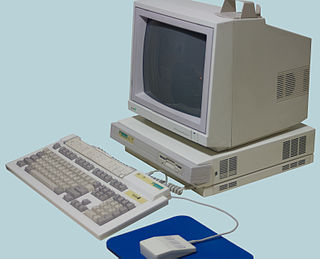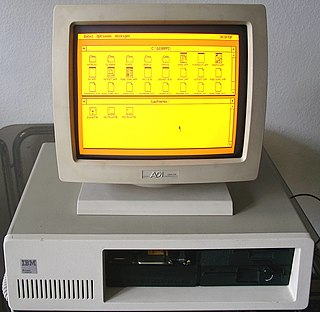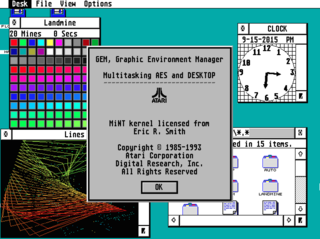Related Research Articles

The history of the graphical user interface, understood as the use of graphic icons and a pointing device to control a computer, covers a five-decade span of incremental refinements, built on some constant core principles. Several vendors have created their own windowing systems based on independent code, but with basic elements in common that define the WIMP "window, icon, menu and pointing device" paradigm.
Desktop publishing (DTP) is the creation of documents using dedicated software on a personal ("desktop") computer. It was first used almost exclusively for print publications, but now it also assists in the creation of various forms of online content. Desktop publishing software can generate page layouts and produce text and image content comparable to the simpler forms of traditional typography and printing. This technology allows individuals, businesses, and other organizations to self-publish a wide variety of content, from menus to magazines to books, without the expense of commercial printing.

The Acorn Archimedes is a family of personal computers designed by Acorn Computers of Cambridge, England. The systems in this family use Acorn's own ARM architecture processors and initially ran the Arthur operating system, with later models introducing RISC OS and, in a separate workstation range, RISC iX. The first Archimedes models were introduced in 1987, and systems in the Archimedes family were sold until the mid-1990s alongside Acorn's newer Risc PC and A7000 models.

Ventura Publisher was the first popular desktop publishing package for IBM PC compatible computers running the GEM extension to the DOS operating system. The software was originally developed by Ventura Software, a small software company founded by John Meyer, Don Heiskell, and Lee Jay Lorenzen, all of whom met while working at Digital Research. It ran under an included run-time copy of Digital Research's GEM.

GEM is a discontinued operating environment released by Digital Research in 1985. GEM is known primarily as the native graphical user interface of the Atari ST series of computers, providing a WIMP desktop. It was also available for IBM PC compatibles and shipped with some models from Amstrad. GEM is used as the core for some commercial MS-DOS programs, the most notable being Ventura Publisher. It was ported to other computers that previously lacked graphical interfaces, but never gained traction. The final retail version of GEM was released in 1988.

RISC OS is a computer operating system originally designed by Acorn Computers Ltd in Cambridge, England. First released in 1987, it was designed to run on the ARM chipset, which Acorn had designed concurrently for use in its new line of Archimedes personal computers. RISC OS takes its name from the reduced instruction set computer (RISC) architecture it supports.

RISC iX is a discontinued Unix operating system designed to run on a series of workstations based on the Acorn Archimedes microcomputer. Heavily based on 4.3BSD, it was initially completed in 1988, a year after Arthur but before RISC OS. It was introduced in the ARM2-based R140 workstation in 1989, followed up by the ARM3-based R200-series workstations in 1990.
Xara is an international software company founded in 1981, with an HQ in Berlin and development office in Hemel Hempstead, UK. It has developed software for a variety of computer platforms, in chronological order: the Acorn Atom, BBC Micro, Z88, Atari ST, Acorn Archimedes, Microsoft Windows, Linux, and more recently web browser-based services.
The Acorn Business Computer (ABC) was a series of microcomputers announced at the end of 1983 by the British company Acorn Computers. The series of eight computers was aimed at the business, research and further education markets. Demonstrated at the Personal Computer World Show in September 1984, having been under development for "about a year" and having been undergoing field trials from May 1984, the range "understandably attracted a great deal of attention" and was favourably received by some commentators. The official launch of the range was scheduled for January 1985.
Fleet Street Publisher was an Atari ST desktop publishing program produced by Mirrorsoft in the United Kingdom and released in November 1986. A IBM PC compatible version produced by Rowan Software was planned for 1987 but never released.
GST was a group of computer companies based in Cambridge, England, founded by Jeff Fenton in June 1979. The company worked with Atari, Sinclair Research, Torch Computers, Acorn Computers, Monotype Corporation and Kwik-Fit, amongst others.

TOS is the operating system of the Atari ST range of computers. This range includes the 520ST and 1040ST, their STF/M/FM and STE variants and the Mega ST/STE. Later, 32-bit machines were developed using a new version of TOS, called MultiTOS, which allowed multitasking. More recently, users have further developed TOS into FreeMiNT.

Acorn User magazine was founded by Acorn Computers in 1982, contract-published by Addison-Wesley, to coincide with the launch of the BBC Micro. It covered the range of Acorn home computers, the BBC Micro and Atom at first and later the Electron, Archimedes and Risc PC.
Protext is a British word processing program, developed by Arnor Ltd, of Peterborough in the decade following 1985. Originally written for the Amstrad CPC 464, it was later sold for the Amstrad PCW series of word processors, for MS-DOS based PCs, the Atari ST, and the Commodore Amiga.

1st Word is a word processor program for the Atari ST developed by GST Computer Systems and published in 1985. It was given away with all ST systems from December 1985 for the next two years. Although it was relatively well received, it was a very simple program, lacking most power features and was very slow when working in large documents. In spite of any limitations, its wide availability made the program's .DOC file format became a de facto standard for the platform and was widely supported by other programs like desktop publishing systems.
RISC OS, the computer operating system developed by Acorn Computers for their ARM-based Acorn Archimedes range, was originally released in 1987 as Arthur 0.20, and soon followed by Arthur 0.30, and Arthur 1.20. The next version, Arthur 2, became RISC OS 2 and was completed and made available in April 1989. RISC OS 3 was released with the very earliest version of the A5000 in 1991 and contained a series of new features. By 1996 RISC OS had been shipped on over 500,000 systems.
Gordon J. Key authored video game software for the Acorn BBC Micro, Electron and RISC OS platforms in the 1980s and 1990s. His most well-known works were published by The Fourth Dimension. He is also credited with additional programming routines in FedNet's futuristic flight combat game Star Fighter 3000 (1994), and authored Party Machine for the Amstrad CPC.
Impression is a desktop publishing application for RISC OS systems. It was developed by Computer Concepts and initially made available in pre-release form during 1989, having been demonstrated in February 1989 at the Which? Computer Show and subsequently announced as being available from June 1989. The "completed" version was eventually delivered on 18th January 1990.
Timeworks, Inc., later Timeworks International, Inc., was a private American software publisher active from 1982 to 1994 and based in Chicago, Illinois. The company primarily sold entry-level productivity software, as well as advanced desktop publishing applications and video games. They are perhaps best known for Publisher, their flagship desktop publishing application. In 1993, they were acquired by Megalode Resources, Inc., of Burlington, Ontario, who operated the company until 1994.
References
- ↑ "Atari ST Timeworks DTP: scans, dump, download, screenshots, ads, videos, catalog, instructions, roms". Atarimania.com. 2016-07-31. Retrieved 2016-08-09.
- 1 2 "Publisher 4.6 Home & Business (PC CD) : Amazon.co.uk: Software". Amazon UK.
- ↑ "Review: Desktop Publisher ST (Timeworks)". Atarimagazines.com. Retrieved 2016-08-09.
- ↑ Nelson, Bruce D. "Atari Explorer, Z*Net, & ST Report: Z*Net: 10-Apr-92 #9215". Atariarchives.org. Retrieved 2016-08-09.
- ↑ "Acorn reveals Arc DTP plans". Acorn User. July 1988. p. 7. Retrieved 2021-04-14.
- ↑ "Archimedes set for desktop publishing". Acorn User. November 1988. p. 9. Retrieved 2021-04-14.
- ↑ Power Over the Printed Page (PDF). Acorn Computers Limited. May 1989. p. 3. Retrieved 2021-04-19.
- 1 2 "The Acorn Publishing System". The Archimedean. No. 5. 1992. p. 6. Retrieved 2021-02-13.
- ↑ "Ovation - Software - Computing History". www.computinghistory.org.uk. Retrieved 2022-11-21.
- 1 2 Bell, Graham (November 1990). "In Ovation". Acorn User. pp. 91–93. Retrieved 2021-04-16.
- 1 2 "Price List". Clares Micro Supplies Ltd. 2000-01-11. Archived from the original on 2000-01-18. Retrieved 2021-04-16.
- ↑ Bell, Graham (October 1989). "Hold the Font Page". Acorn User. pp. 134–135. Retrieved 2021-04-14.
- ↑ "BBC Acorn User 1989/90 Awards". Acorn User. February 1990. pp. 63–65, 67, 69. Retrieved 2021-04-14.
- ↑ Kreindler, Jack; Hill, Martin; Capper, Alan (September 1996). "DTP excellence". Acorn User. pp. 32–35. Retrieved 2021-04-16.
- ↑ Moxon, Mark (August 1995). "Applause for thought". Acorn User. pp. 42–43. Retrieved 2021-04-16.
- ↑ Look, Adrian (November 1989). "PC Show Report". Archive. pp. 32–35. Retrieved 2021-04-16.
- ↑ "New Products from Clares". Risc User. October 1989. p. 5. Retrieved 2021-04-16.
- ↑ "Forthcoming Products". Archive. September 1989. p. 3. Retrieved 2021-04-16.
- ↑ Lynch, Ian (March 1990). "DTP Column". Archive. pp. 36–37. Retrieved 2021-04-16.
- ↑ Colombat, Tony (August 1991). "Using a Second Floppy Drive". Archive. pp. 23–24. Retrieved 2021-04-16.
- ↑ Smith, Bruce (November 1990). "Bruce's Software Workshop". A&B Computing. pp. 41–44.
- ↑ "Acorn Comes to Aid of Third Party". Acorn User. October 1990. p. 7. Retrieved 2021-04-16.
- ↑ PC Mag. 1989-01-17. p. 34. Retrieved 2016-08-09.
- ↑ "It's No Contest!". InfoWorld : 10. 1989-09-11. Retrieved 2016-08-09.
- ↑ "Key Publisher 1.x". WinWorld.
- ↑ "Publish-IT 1.x". WinWorld.
- ↑ "Publish-It! (Apple II, 5 1/4" Disk) Timeworks - 1987 USA, Canada Release". Eli's Software Encyclopedia. 2010-03-07. Retrieved 2016-08-09.
- ↑ Desktop publishing Computing History
- ↑ Inc, InfoWorld Media Group (1990-10-08). "InfoWorld". InfoWorld Media Group, Inc. – via Google Books.
{{cite web}}:|last=has generic name (help) - ↑ "Publish-IT 2.0". WinWorld.
- 1 2 Inc, InfoWorld Media Group (1991-06-10). "InfoWorld". InfoWorld Media Group, Inc. – via Google Books.
{{cite web}}:|last=has generic name (help) - ↑ "Publish-IT Easy 2.x". WinWorld.
- ↑ "Business Publishing". Hitchcock Publishing Company. 1992-08-07 – via Google Books.
- ↑ "Timeworks Publisher". 1992-08-07 – via Internet Archive.
- ↑ "Publish-IT 4.0". WinWorld.